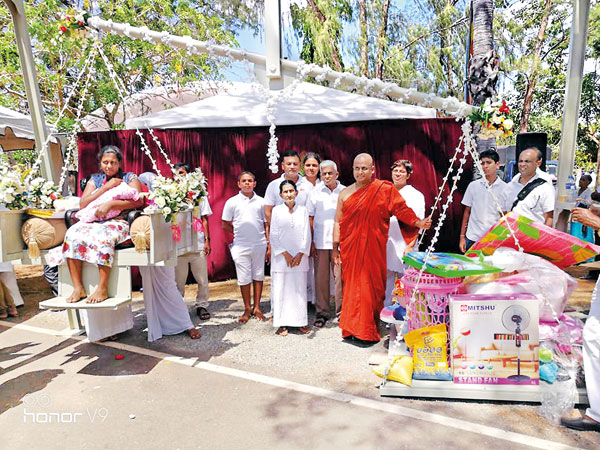Sunday Times 2
Tulabhara: An age-old tradition revived for a worthy cause
Traditionally, Sri Lankans are well known for their generosity, particularly when it comes to feeding the maha sangha and the poor. From the early times it was the royalty that was in the forefront in liberality. King Devanampiyatissa had constructed a refectory called Mahapali to store the provisions for a thousand bhikkhus. According to Mahavamsa, in forty places, King Dutugemunu had commanded the perpetual giving of rice foods prepared with honey. A 19-metre-long canoe carved out of granite lying today in the Abhayagiri stupa premises in Anuradhapura had the capacity to hold food given as alms sufficient for 5,000 monks. The canoe was filled with cooked rice and a smaller granite canoe lying close by would have been used for curries. Incidentally, Faxian, the Chinese pilgrim who visited Sri Lanka in the early 5th century and lived here for two years, had recorded that 5,000 monks lived at Abhayagiriya temple.

Revival of Thulabara: A boon for expectant mothers
In ancient times, there was another form of generosity undertaken by the kings known as “Tulabhara dana” (Tula meaning a weighing scale and dana meaning almsgiving, liberality and offering). A donation made to the needy mainly with food or other requisites equal to the weight of the donor who sits on one side of the scales while the other side was being filled with whatever the donor wanted to distribute among the poor.
A number of references are made to such “tulabhara dana” in Sinhala classical literature and chronicles. Thupavamsa records King Bhatiya carrying out a tulabhara dana for the triple gem — meaning Buddha, dhamma and sangha. Culavamsa mentions that King Vijayabahu I thrice dispensed alms to the poor of a weight equal to that of his body. Parakramabahu I had summoned the beggars every year and performed the tulabhara dana. Nissankamalla was the last king to have given a tulabhara dana. After that no mention has been made in classical literature about this practice.
On the last full moon day of September, I was a witness to a historic event — the revival of this age-old tradition by the Ven. Tallale Chandakitti Thera, the chief incumbent of Narada Dharmayatanaya in Colombo 7. The ceremony gave the tradition a new meaning and a new purpose. To commemorate 30 years of pabbajja (priesthood) of the Ven Chandakitti Thera, the dayakas in consultation with the Venerable Thera had carefully selected fifty mothers expecting their third baby and presented them with all the requirements (worth seventy five thousand rupees each), needed for a mother and baby for one year. The mothers were from poverty stricken families in and around Anuradhapura. The ceremony was attended by a large number of bhikkhus and laymen at Vajiraramaya in Anuradhapura.
Unlike on previous occasions when provisions were provided to the weight of the giver, here, it was the weight of the recipient that mattered. One by one, the mothers were led to a well decorated weighing scale specially made by an engineer and helped to sit on one side of the scale while the other side was filled with the requirements they and their babies needed for the next twelve months. It was a pleasant sight to see the coy, smiles of the young mothers beaming with happiness as they got down from the scale hugging the Buddha statue, which was among other things, perhaps, the most valuable gift they received. I walked away thinking of the fifty fortunate children who, no doubt, would be beacons of light that will illuminate this punya bhumi (fortunate land) on a future day.
It was a historic event for more than one reason. It was a revival of an age-old tradition after the Polonnaruwa period .It was not the weight of the benefactor that mattered but the weight of the beneficiary. The beneficiaries were selected from a highly vulnerable section of society. The most important factor was that what was performed earlier by the kings as individuals with the expectation of receiving merit, has now passed on to the maha sangha and is being performed as a collective community project. It is a project which needs to be encouraged wherever feasible.
Sri Lanka has again demonstrated to the world that its sense of generosity is yet alive.
Incidentally, a UK-based independent organisation, “Charities Aid Foundation” looked at how and why people around the world give to charity. “Generosity across the World”, the eighth edition of the CAF World Giving Index, (2017) had collected data from 139 countries, which represented an incredible 95% of the world’s population, and Sri Lanka has ranked eighth for the past five years. Myanmar was first for five consecutive years. Some of the well-known donor countries were way behind.
(The writer was a member of the former Ceylon Civil Service and is the author of about 35 books.)

